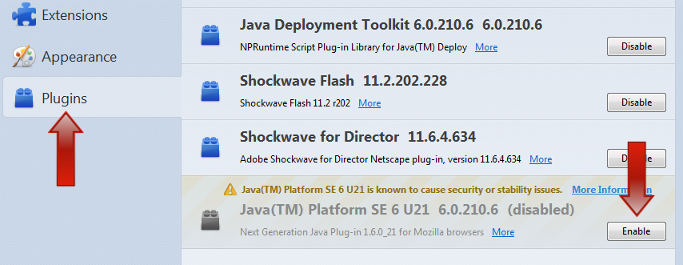

Start Firefox and validate by going to Tools > Addons > Plugins. Be sure you’re in lib64!Ĭreate symbolic link to the plugin: ln -fs /usr/java/jre1.7.0_21/lib/amd64/libnpjp2.so libnpjp2.so There is also a /usr/lib/mozilla/plugins directory. | grep libnpjpįor me, that returned: /usr/java/jre1.7.0_21/lib/amd64/libnpjp2.soĬhange to directory for Firefox plugins: cd /usr/lib64/mozilla/pluginsīe careful. rm -rf /home/basejump/Downloads/jre-7u21-linux-圆4.rpmįrom the /usr/java directory, Find the Firefox plugin (which gets installed with java): find.
#Find java plugin for firefox mac os x#
In the list on the right select, the Java Plugin - the name of the plugin will vary depending on whether you are a Mac OS X or Windows user. mkdir /usr/javaĮxecute rpm on the Java RPM you just downloaded… rpm -ivh /home/basejump/Downloads/jre-7u21-linux-圆4.rpmĭelete the original RPM you don’t need that anymore. To turn on/turn off Java applets in the Firefox browser: Select Tools -> Add-ons from the menu toolbar. enabled line to toggle the setting between true and false as desired.

#Find java plugin for firefox install#
This procedure only works with the version you download from Oracle it will not work with the OpenJDK version of Java you’ll have when using the ‘yum install java’ command.ĭownload Linux 圆4 RPM from Oracle's Java Downloads for All Operating Systems page.Ĭhange to root user and enter password. In Firefox, type about:config in the address bar, then press Enter. Java must be installed on the system first. This is not a descriptive tutorial it’s just quick notes, so you may have to do a little reading between the lines. So, I’m recording what worked for when I have to do it again. The procedure wasn’t too bad, but it wasn’t exactly straight-forward either.

Today, I had to install the Java plugin for 64bit Firefox on CentOS 6.4. Some web page features such as buttons that change when they're clicked or images with zoom capabilities may not work properly while others may not work at all.Install the Java Plugin for 64bit Firefox on CentOS 6.4 If you have JavaScript disabled, most of what makes these websites work won't load in your Firefox browser. The use of JavaScript on your Firefox browser is virtually crucial because it enables the best use of modern websites such as Gmail, Facebook, YouTube, and more. What happens if I disable JavaScript on Mozilla Firefox? If the "javascript.enabled" is set to "true," then your JavaScript is working correctly. Type in "javascript" into this search bar. As you type this, every JavaScript-based setting appear. On clicking the "Accept the Risk and Continue" button, a search feature will appear. To do that, simply input "about:config" into the Address Bar of your Firefox browser and press the Enter key on your keyboard. Next, accept the warning about changing advanced settings by clicking the "I'll be careful, I promise" button. On Mozilla Firefox, JavaScript is enabled by default, but you can check it reasonably quickly to verify if it is working correctly. How do I know if JavaScript is working on Mozilla Firefox? In fact, it should only take you only a minute or so to complete. Enabling JavaScript in your Firefox browser is an easy process. It powers most of the dynamic features you see on web pages, including button clicks, navigations, and form submissions. JavaScript is a popular programming language that's essential for modern websites to function correctly on Mozilla Firefox. Why do I need JavaScript enabled on Mozilla Firefox?


 0 kommentar(er)
0 kommentar(er)
